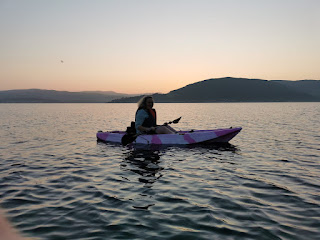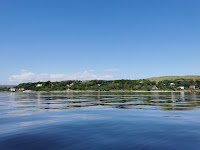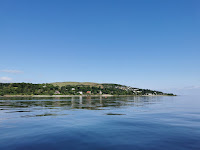Schools in Argyll
and Bute finished for the summer holidays yesterday, so at one o’clock I found myself singing my
annual rendition of Alice Cooper’s Schools Out for Summer, although with a
little less enthusiasm than I perhaps used to when I was a classroom teacher.
At least I have six weeks ahead of me without an alarm going off at seven in
the morning even if I do have to entertain my kids more often!

As soon as the
girls were home, they wanted to go to the beach and, as it was too choppy for
the paddle boards, they went swimming while I took my kayak out. After a rather
dodgy attempt to get into it, I finally managed without either capsizing or being
washed up onto the beach. I did, however, discover that my plan to paddle
leisurely up and down the shoreline was simply not going to happen. The waves
were high enough that the safest option was to head directly into them at
ninety degrees, then turn as quickly as possible and head back to shore the
same way. (The photos were taken on better days!)This meant that I
found myself further out into the sea-loch than I usually go, giving me a different
perspective of the peninsula I live on. This idea of looking at the place I am
so familiar with from a different point of view (a novel point of view?) has always been intriguing to me. It was when I discovered that there had been a Viking fort on
the site of a friend’s
house, and human remains found in my parent’s garden (in Victorian times —
thankfully I didn’t have to even consider the possibility of Mum having buried
someone under the patio — maybe I'll save that idea for a future book…) that I thought about setting
a Viking series here.
So little is known
about the ancient kingdom of Strathclyde that it doesn’t often feature in novels and it’s
divided from modern Scotland by language — they most likely spoke Brythonic or
Cumbric, a language closer to modern Welsh than modern Gaelic — but
nevertheless, there are remnants throughout the area of links with the Norsemen
if you know where to look. (Knockderry, Luss, Carrick Golf Course, Dumbarton Rock and Govan,
to name but a few.) These remnants may not add up (yet) to a significant
relationship between the two peoples, so I have kept these interactions minimal
in my novels, but there are enough to suggest that there was definitely some
level of significant contact.
It
’s not until you are actually out
there on the loch that you see the water as forming a connection, rather than
it being a division. Places that are far distant by road suddenly become the
closest town. People that you would be unlikely to meet on land
suddenly become the very people you are most likely to bump into. The long
fingers of the peninsulas that form the northern banks of the Firth of Clyde
suddenly become accessible to one another, rather than separated by hundreds of
miles of long, narrow, winding roads.
Perhaps this is
something writers always do — distance themselves from places and people and
perhaps even themselves — so that they can tell these other stories, but I
think, for me, anyway, that it’s
more pronounced when writing historical fiction. Looking back at the landscape
in front of me from far out on the water, I imagined what it would have looked
like then. There would, of course, have been the same basic bare bones of the
landscape, but what areas would have been attractive to live on? Where had the
best access to the sea-loch and streams? Where is the flattest land for
building? What would those buildings look like? Sadly, my artistic skills don’t
extend to me drawing an image, so I have to use words and hope that
readers can picture it roughly the way I have — or maybe that doesn’t matter?
Maybe it’s okay for them to picture it their own way?

Our new schedule for the
Novel Points of View blog has meant that, rather serendipitously, I have ended
up being the one to blog the weekend prior to the release of book three of my
series. The Viking’s
Princess Bride will be released on Tuesday July 5th.
Thanks to various delays, it’s
not particularly seasonal as it’s set at Imbolc in early February and features
the two main characters snowbound in a shieling high on the moors. Shielings
were dwelling houses used primarily by women during the summer when they took
the sheep up onto the moors to give them access to richer grasslands. This is
Scotland, however, so I’m not going to jinx our summer weather by saying that
the presence of snow indicates that the events couldn’t happen in July!
I hope everyone has a lovely summer and sees the sun at
least once or twice!
Mairibeth






So interesting and so cleverly written!
ReplyDeleteFabulous blog post, thank you! Makes me want to drive straight up to Scotland.
ReplyDeleteWhat an interesting post, Mairibeth - beautiful photos too. I love the idea of places seeming closer when bound by water. Many congratulations on the publication of The Viking's Princess Bride, and enjoy those summer hols!
ReplyDeleteDefinitely good for readers to be able to imagine their own landscape for a novel - they can see it in so many real places afterwards, that this is where the boats would be launched, that's where the hall would be built.
ReplyDeleteFascinating to think of the Vikings so close to home! Good luck with the book, looking forward to reading it. Carol
ReplyDelete